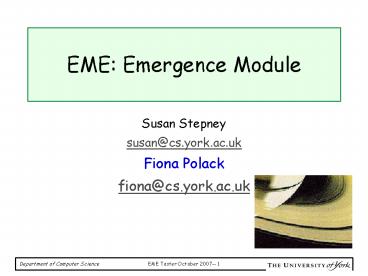EME: Emergence Module PowerPoint PPT Presentation
1 / 12
Title: EME: Emergence Module
1
EME Emergence Module
- Susan Stepney
- susan_at_cs.york.ac.uk
- Fiona Polack
- fiona_at_cs.york.ac.uk
2
What is an emergent system?
- Many simple elements, no central control
- Overall behaviour that is not an obvious
consequence of behaviour of elements - Construction by insects
- Crowd or flock behaviour by people, birds,
insects - Plants grown using simple growth algorithms
- Animals developed from simple cells
3
Why study emergent systems?
- Emergent systems cannot be understood by direct
extension of conventional systems ideas - An emergent system is a system of systems
- Emergent properties at system level
- Components at system level
- Emergence requires a change in scale
- Small systems combine to larger-scale effect
- This will not make sense if you are
colour-blind or reading in b/w!
4
How can an emergent system be engineered?
- Through studying lots of emergent systems
- Well cover various sorts in EME
- By considering levels and the environment
- Polack and Stepney work on architectural aspects
of emergent system development - Through simulation and real-world observation
- What needs to be modelled to faithfully simulate
emergence? - Paying attention to dependability assurance
5
What will we look at?
6
CA demonstrate complex behaviour from simple
rules
- CAs
Time 1
- Game Of Life CAs
- http//www.math.com/students/wonders/life/life.htm
l
- Langtons self-replicating loops
- http//necsi.org/postdocs/sayama/sdsr/java/
7
What will we look at?
- Demonstrations that complex behaviour emerges
from multiple instances of simple systems - L-systems
- Aristid Lindenmeyer Przemyslaw Prusinkiewicz
- biological metaphor plant branching growth
- eg. a bud becomes a twig, a twig gains buds,
8
What will we look at?
- Demonstrations that complex behaviour emerges
from multiple instances of simple systems - L-systems
- Aristid Lindenmeyer Przemyslaw Prusinkiewicz
- biological metaphor plant branching growth
- eg. a bud becomes a twig, a twig gains buds,
- a production replaces a parent module with a
child module - pn symbol ? rewrite_string
- bud ? twig p1 B ? T
- twig ? twig bud bud p2 T ? TBB
9
What will we look at?
- Demonstrations that complex behaviour emerges
from multiple instances of simple systems - L-systems
- Aristid Lindenmeyer Przemyslaw Prusinkiewicz
- biological metaphor plant branching growth
- eg. a bud becomes a twig, a twig gains buds,
Prusinkiewicz Lindenmeyer, fig 1.24a, c, d,
1.10, 1.24f, 1.8
10
What will we look at?
- Demonstrations that complex behaviour emerges
from multiple instances of simple systems - and various other artificial complex systems
11
What will we look at?
- Demonstrations that complex behaviour emerges
from multiple instances of simple systems - Nanotechnology
- molecular nanotech
- little things that make big things
- Nanobot constructors and replicators
Design for a fine-motion controller for molecular
assembly - 3000 atoms, lt1nm http//www.imm.org/
12
Engineering
- Not much work has been done on engineering
- Most artificial emergent systems are hacked
- Conways Game of Life CA was discovered by
playing with patterns on a GO board - Proposals for real-world nano-scale assemblers
and disassemblers make engineering urgent - Well look at
- Identifying and measuring emergence
- Layers in emergent systems
- Towards assurance-directed development frameworks

